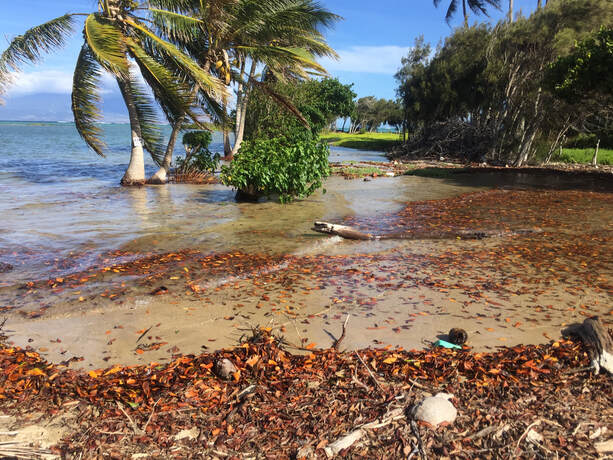KILO: OBSERVATIONS
our data collection and analysis is based on the traditional, indigenous practice of kilo: a relationship of familiarity between surrounding elements and the senses of the observer. This customary practice is the foundation of proper konohiki land and fishery management techniques, assisted by modern developments in methods and instruments.
SEA LEVEL RISE & THE FUTURE OF KUPEKE LOKO IʻA
We accept the fact that Kupeke Loko Iʻa will not be spared from the global impacts of climate change and sea level rise. As with other fishpond sites, restoration will become increasingly challenging over the course of the decades ahead. some issues that affect the health and function of Kupeke Loko Iʻa include:
-native wetland habitat loss due to development.
-incompatible, invasive plant growth.
-coliform bacteria from sewage system leachate
-increased erosion rates from higher-than-normal tidal activity and heavier rain storms.
-average tide heights breaching the current maximum height of the fishpond wall.
These are commonly identified issues among many other fishponds in hawaiʻi. We plan to find solutions to these issues before they happen, and we look forward to sharing and trading information and resources provided by the Hui Malama Loko Iʻa network of Hawaiʻi fishpond Kiaʻi groups. kuahawaii.org/huimalamalokoia/
-native wetland habitat loss due to development.
-incompatible, invasive plant growth.
-coliform bacteria from sewage system leachate
-increased erosion rates from higher-than-normal tidal activity and heavier rain storms.
-average tide heights breaching the current maximum height of the fishpond wall.
These are commonly identified issues among many other fishponds in hawaiʻi. We plan to find solutions to these issues before they happen, and we look forward to sharing and trading information and resources provided by the Hui Malama Loko Iʻa network of Hawaiʻi fishpond Kiaʻi groups. kuahawaii.org/huimalamalokoia/
WATER QUALITY MONITORING
A variety of juvenile fish are drawn to the loko iʻa for safety and nutrients required for growth to maturity. this is the main function of the loko iʻa, a pond for fish to grow in (which is why we call them fishpond, and not FISHINGpond). The pond can offer these needs, so long as they are maintained. A clean, adequate supply of groundwater is vital to the health of the loko iʻa, and overall reef fishery. Our modern instrument cache is limited to a few pieces of simple equipment, so we rely primarily on traditional methods of data collection.
Several methods of data collection used at Kupeke: gauges, scopes, and bio-indicators.
SITE MANAGEMENT & BIOSECURITY
Prior to management efforts beginning in 2018, Kupeke fishpond was unregulated, thereby rendering all species within Kupeke loko iʻa vulnerable to poaching. Since active management and regulation was initiated, area residents have noticed the increase in the fish population inside the fishpond. To be clear: no access to the pond is allowed without permission by management (Laʻa Poepoe).






